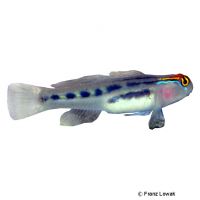Twinspot Combtooth-Blenny (Ecsenius bimaculatus)
| Twinspot Combtooth-Blenny Ecsenius bimaculatus | |
|---|---|
| Name | Twinspot Combtooth-Blenny |
| Name Lat. | Ecsenius bimaculatus |
| Family | Combtooth Blennies |
| Family lat. | Blenniidae |
| Order | Blennies |
| Order lat. | Blenniiformes |
| Origin | Western Pacific |
| Habitat | Coral reefs |
| Diet | Omnivore |
| pH | 8.1-8.4 |
| Hardness | 8-10 °KH |
| Behavior | Peaceful |
| Keeping | Individual |
| Reef Compatible | Yes |
| Care Level | Moderate |
| Life Span | N/A |
| Protection | No |
| Metric Units | |
| Size | 5 cm |
| Temperature | 25-28 °C |
| Salinity | 33-36 ‰ |
| Aquarium | ~ 200 l |
| US Units | |
| Size | 2" |
| Temperature | 77-82 °F |
| Salinity | 1.020-1.025 sg |
| Aquarium | ~ 50 gal |
Distribution and habitat
The range of Ecsenius bimaculatus is in the western Pacific Ocean, extending from the Philippines to northeastern Borneo. They live there on rocks and reef slopes with rich coral growth to depths of 15 m.
Maintenance
They need a well-structured aquarium with a reef structure (hiding, resting and retreat possibilities), with living stones, which they can graze on and which act like a biological filter as well as a not too fine, deep substrate. Only lime-rich, heavy metal-free sands, gravels, stones or sea sand of various grain sizes may be used as substrate
Filters, skimmers and heaters are necessary to ensure water quality, as well as pumps to simulate tides, swells and bottom currents. Lighting must correspond to the species-appropriate day-night rhythm of the animals
| Salinity: 33-36 ‰ | pH value: 8.1-8.4 |
| Carbonate hardness: 8-10 °KH | Nitrate content: 2-8 mg/l |
| phosphate content: 0.01-0.1 mg/l | nitrite content: 0.0-0.05 mg/l |
For salinity, an average value should be aimed for, which may only vary slightly by +/- 0.5 ‰. Ammonia and ammonium must not be measurable. Special attention must be paid to constantly good water quality.
Diet
In nature they feed mainly on zooplankton and algae. The feed change usually succeeds without problems. The food supply should consist of a commercially available, vitamin-enriched, frozen special food mix for planktivores or live and frozen food such as mysis, artemia, bosmids, cyclops and plankton. In addition, they need plenty of commercially available algae and kelp (e.g. nori, caulerpa, kelp) supplemented with high-quality flake or granulated food for herbivores, which is usually accepted after an acclimation period. The plant food strengthens their immune system and reduces aggression
It is recommended to feed small portions several times a day (3-5 times). Regular and varied feeding promotes health and increases resistance.
Behaviour and compatibility
In nature they live mostly solitary. They behave very territorial and aggressive within the species, therefore the keeping of several animals is only recommended in a larger and richly structured tank, where each animal has its own hiding place. A socialization with other fish is well possible.
Sex dimorphism
The females are much smaller than the males with about 3 cm. During the mating season, males and females are colored differently.
Reproduction and breeding
There are no known reports of successful breeding in the aquarium. They are cave breeders and the males perform the brood care.
Important
Well-run coral aquariums with abundant small fauna provide optimal conditions for keeping them. As coral reef dwellers, they should not be kept in a fish-only aquarium.
If different species are kept together, care should be taken to ensure that the fish match each other in terms of water quality and temperature requirements and social behavior, and that the setup meets the needs of all species kept together. New fish to be introduced must be acclimated slowly to the water in the aquarium
Further literature can be found in your pet store.
References
Text: Werner Winter; Image: Franz Lowak
Source: KUITER, DEBELIUS (2007): Atlas der Meeresfische: Die Fische an den Küsten der Weltmeere, Kosmos Verlag; BAENSCH & PATZNER (1998): Meerwasser Atlas Bd. 7, Mergus Verlag; ENGELMANN (2005): Zootierhaltung - Tiere in menschlicher Obhut: Fische, Verlag Harri Deutsch
- Gemäß § 21 Abs. 5 Tierschutzgesetz idgF
